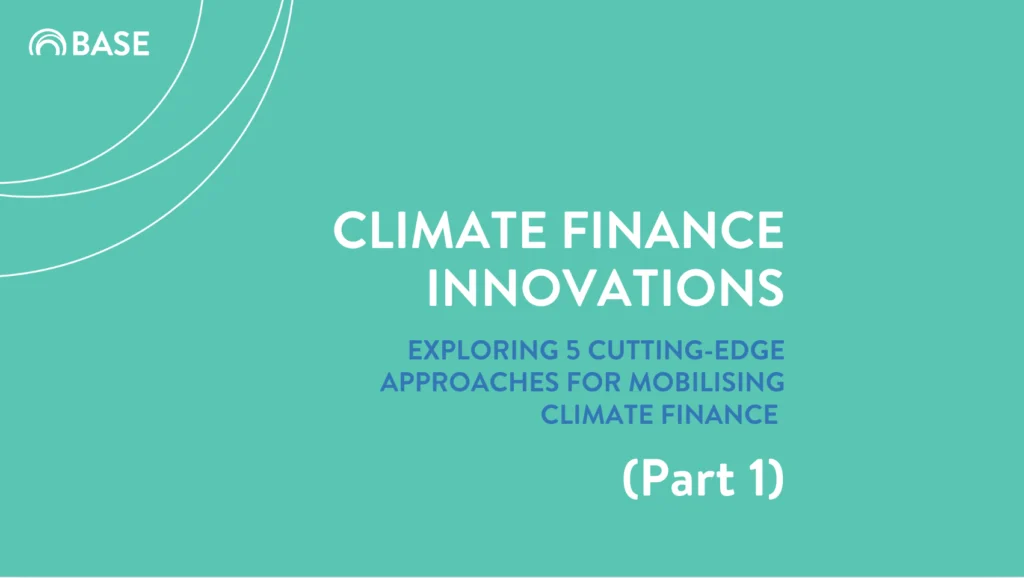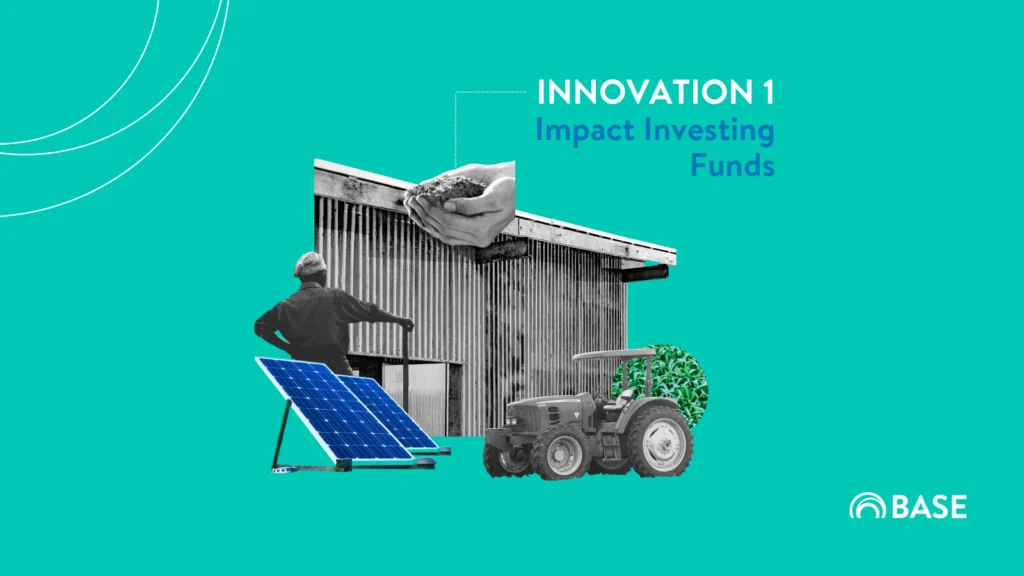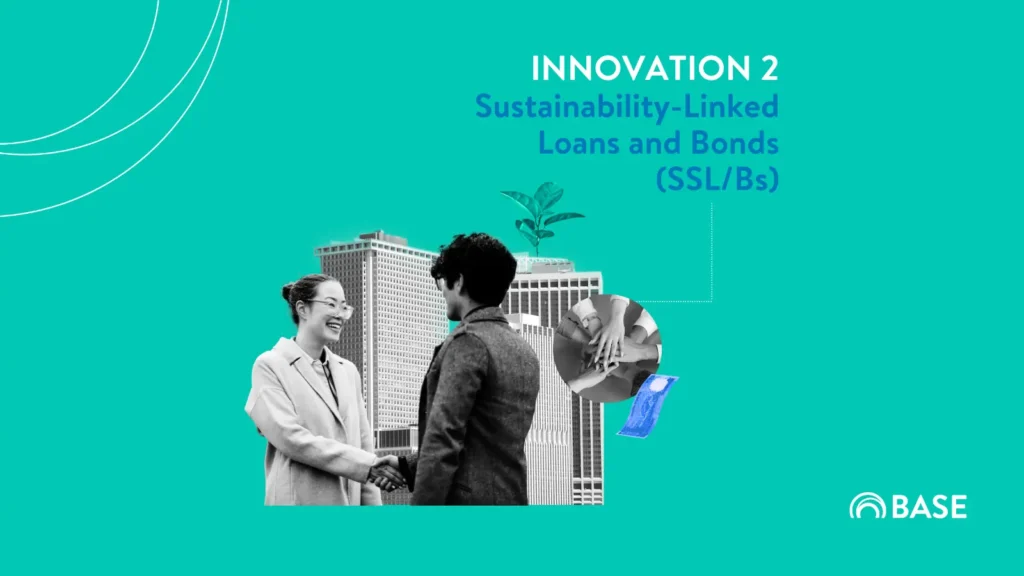
As the urgency to mitigate climate change and adapt to its impacts intensifies, the world faces a critical challenge: mobilising sufficient capital to finance the ecological transition. This necessitates innovative solutions that can bridge the gap between traditional finance and the unique needs of more climate-conscious projects.
This two-part article, collaboratively drafted by BASE’s specialists of diverse backgrounds and experiences, looks into five transformative climate finance innovations poised to play a pivotal role in unlocking new sources of funding for green, blue and, more generally, sustainable projects. From sustainability-linked loans and bonds to impact investment funds and blue finance, these approaches offer a glimpse into the future of climate finance, where innovative financial instruments and strategic partnerships pave the way for a more sustainable and resilient global economy.
This first chapter features a detailed introduction to three of these innovations:
Impact Investment Funds

The size of the impact investing market currently stands at USD 1.16 trillion in assets under management, of which just under 40 percent is directed to developing countries. In comparison, the financing gap to achieve the Sustainable Development Goals (SDGs) targets in developing countries amounts to about USD 4 trillion. Current funding for climate mitigation and adaptation remains well below the scale needed to meet the current and future challenges of the environmental crisis, but impact investors can play a key role in mobilising capital for climate change solutions in developing countries.
An impact investment fund is a type of investment vehicle that seeks to generate positive social or environmental impact alongside financial returns. Impact investing aims to allocate capital to projects, companies, or organisations that address sustainable challenges while making a profit. Social goals typically include poverty alleviation, affordable housing or healthcare access, while environmental objectives can be related to sustainable agriculture, energy access, or cleaner energy technologies. Assessing the effect of financing is a core aspect of impact investing, and funds utilise various methodologies to track their contributions and measure the potential benefits created. This type of facility brings together individual and institutional investors pursuing both financial returns and a positive impact.
Impact funds help mitigate investment risks associated with sustainable solutions by leveraging their expertise, conducting thorough due diligence, and maintaining diversified portfolios. Indeed, these firms specialise in evaluating sustainability-focused investments, considering both financial viability and impact potential. By spreading investments across sectors, geographies, and asset classes, impact funds reduce the risk of any single investment underperforming. Furthermore, they usually prioritise impact measurement and reporting, establishing clear metrics to assess the social and environmental performance of their portfolio companies. Such transparency enables investors to monitor progress, make informed decisions, and manage risks effectively. Additionally, impact funds often provide valuable support, including mentorship and access to networks, to their portfolio companies.
Impact funds can act as “anchor investors” and help to mobilise other investors by demonstrating trust in the projects. This can be especially important in developing countries, where perceived risks may deter investments.
By combining public and philanthropic funding with private capital, blended finance can bring multiple benefits to impact investment funds. It can significantly contribute to de-risk investments by providing guarantees, hence unlocking new capital by attracting hesitant private investors. Moreover, as public and philanthropic funding is generally impact-focused and subject to strict management transparency requirements, it helps ensure investments’ impact and focus on delivering positive outcomes.
Sustainability-Linked Loans & Bonds

Sustainability-linked loans and bonds (SLL/Bs) are innovative sustainable finance products that allow borrowers to access more affordable financing against the condition they pursue and successfully achieve sufficiently ambitious and quantifiable environmental and social impact. Indeed, under SLL/Bs, the price of financing (i.e., the margin or coupon) depends upon the reach of predetermined sustainability performance targets (SPTs) measured using one or more key performance indicators (KPIs).
Such ‘sustainability-linked’ products are distinct from ‘use of proceeds’ products, such as Green bonds or social loans, which offer funding exclusively directed towards either or both green and social projects. In the case of SLL/Bs, the financial resources can be applied indistinguishably, and beneficiaries can unlock benefits in the interest rate if specific milestones related to sustainability are met in the determined period. Therefore, the scheme offers affordable finance and flexibility to the borrowers regarding the use of the provided funding. For private financial institutions, offering SLL/Bs represents an effective tool to transition their portfolio of investments towards ESG goals while creating a new revenue stream and contributing to readiness towards future sustainable banking regulations.
SLL/Bs are also proving to represent an effective tool to finance sustainability-related endeavours. In such a case, since the financing is not tied to a specific project, this flexibility empowers borrowers to determine the most effective means of achieving their goals. For instance, if a company requires a loan to enhance the energy efficiency of its operations up to a measurable KPI, an SLL allows its management to investigate and decide whether upgrading equipment, reinforcing insulation, improving processes or any other measures would represent the best solution to improve performance. In this respect, SSLs also promote a technology-agnostic approach and, more generally, foster openness to a diverse range of solutions when employed for sustainability actions.
Moreover, by offering SSLs instead of conventional loans, financial institutions empower companies to make environmental or social progress, stimulating a transition in the case they were not initially focused on attaining such objectives. Indeed, the possibility of reducing the interest rate provides a strong incentive to pursue sustainable practices and obtain tangible outcomes. In the experience of BASE, SLLs granted to private financiers by multilateral institutions act as strong levers for actions aimed at enhancing organisational strategic transformation that has an impact on their portfolios, activities, clients, and therefore the real economy.
For these reasons, and due to the increasing demand for sustainability impact reporting, SLLs are gaining significant attention in the financial sector. The main risks inherent to this model revolve around a failure to achieve the predetermined targets, which results in a credit cost increase for the borrower, and a lack of transparency on the measurement and communication of KPIs, which can cause friction between both parties and generate reputational damages. To address these, lenders typically hire external validation firms to develop credible and robust targets measurable against an assessed baseline. Such external reviewers are also in charge of verifying the indicators on a regular basis.
Blue Finance

Our oceans and waterways are some of the lifeblood of our planet. They generate over half the oxygen we breathe and are considered “the world’s greatest ally against climate change” by the UN as they represent the largest carbon sink on Earth. Additionally, they constitute vital resources for food and medicine. However, human activities like pollution, overfishing, and global warming are pushing our oceans to a tipping point.
In this context, the Blue Economy, and more particularly Blue Finance, constitutes an emerging field of climate finance gaining significant attention from global investors and international organisations. It presents interesting opportunities to protect clean water access, preserve underwater environments, and foster a sustainable water economy. The ocean economy is projected to double to USD 3 trillion by 2030, generating employment for 40 million people. Innovative financing solutions, such as Blue Bonds and Blue Loans, can play a crucial role in supporting various initiatives aimed at protecting, restoring or sustainably managing water resources and their ecosystems.
Blue Bonds and Blue Loans are pioneering financial instruments that raise funds specifically earmarked for investments in areas such as water and wastewater management, reduction of ocean pollution (including plastic and chemicals), marine ecosystem restoration, sustainable shipping, blue food production and trade, eco-friendly tourism, and offshore renewable energy. Providing clear guidelines and criteria to assess the impact of projects is key to making investments as beneficial as possible.
To this aim, organisations such as the International Finance Corporation (IFC) are developing guidelines and taxonomies to promote transparency and integrity in financing blue economy projects. Drawing upon the Green Bond Principles (GBP) and the Green Loan Principles (GLP), which set such recommendations for projects focusing on fostering “a net-zero emissions economy and protecting the environment”, the IFC produced the Guidelines for Blue Finance, providing an additional framework focusing on the blue economy. To qualify as ‘Blue Eligible’ according to IFC’s standards, an activity must not only align with the above-mentioned green bonds and loans principles but also contribute to one or both of the SDGs related to water resources: SDG 6, “Clean Water and Sanitation,” and SDG 14, “Life below Water.” Additionally, it should present minimal risk of hindering progress on other SDGs.
Development banks and agencies are already working with various stakeholders in all geographies to develop a systematic global blue economy finance market. By offering technical assistance to private banks, working with national regulators to create new financial products, and setting standards to identify opportunities, multilateral organisations are paving the way to realise the potential of investments to have a meaningful impact on our planet’s waters.
➡️ Continue with the second part of the article here.